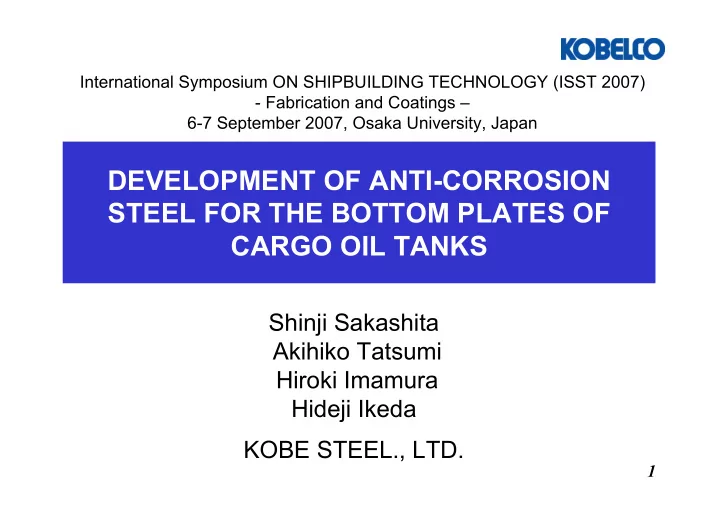

International Symposium ON SHIPBUILDING TECHNOLOGY (ISST 2007) - Fabrication and Coatings – 6-7 September 2007, Osaka University, Japan DEVELOPMENT OF ANTI-CORROSION STEEL FOR THE BOTTOM PLATES OF CARGO OIL TANKS Shinji Sakashita Akihiko Tatsumi Hiroki Imamura Hideji Ikeda KOBE STEEL., LTD. 1
Table of Contents � Background Corrosion problem and countermeasure � Experimental Corrosion mechanism and laboratory test method � Highlight data Performance of anti-corrosion steel � Summary and future plan 2
Corrosion problem ★ Inner bottom Crude oil Pitting corrosion ・ Number: several thousands Environment ・ Depth: ~ 10mm ・ Water (+Cl - ) (in the dock inspection) ・ Oil coating with defect ・ Elemental S Repair by painting and/or welding ・ Low pH solution (in pit) Figure: Corrosion problem in COT of oil tanker (SR242*) 3 * The Shipbuilding Research Association of Japan Panel #242
Countermeasure for Corrosion � Inspection and maintenance after service � Construction period and process of ship � Environmental load minimization Corrosion depth Conventional steel ★ Anti-corrosion steel l e e t s n o i s o r r o c - i t n A Age of ship 4
Corrosion Mechanism (1) Crude oil ・ Anodic reaction : Sludge & corrosion products Fe → Fe 2+ + 2e - (Defect) Brine ・ Cathodic reaction : Oil coat S + 2H + + 2e - → H 2 S Elemental S Bottom plate (several %) Pitting Figure: Corrosion mechanism at the inner bottom of COT (SR242*) * The Shipbuilding Research Association of Japan Panel #242 5
Test method (1) NaCl solution including Crude oil Elemental S Sludge & corrosion products Elemental S (several %) (Defect) Brine Oil coat Specimen 303K Bottom plate Pitting Water bath *Assuming that specimen corresponds to pit inside. Figure: Schematics of simulated corrosion test method for inner bottom plate of COT 6
Corrosion Mechanism (2) Corrosion Mechanism (2) Crude oil ・ Anodic reaction: Fe → Fe 2+ + 2e - (Defect) Brine ・ Cathodic reaction: 1) 2H + + 2e - → H 2 Oil coat Oil coat 2) 2Fe 3+ + 2e - → 2Fe 2+ Fe 3+ Bottom plate Low pH solution (pH<1.5) Pitting Figure: Corrosion mechanism at the inner bottom of COT (SR242) * The Shipbuilding Research Association of Japan Panel #242 7
Test method (2) Fixed temperature and Crude oil humidity chamber Low pH solution 333K, 95%RH (pH<1) (Defect) Brine Oil coat Oil coat NaCl + FeCl 3 solution (pH:1) Bottom plate Pitting Specimen *Assuming that specimen corresponds to pit inside. Figure: Schematics of simulated corrosion test method for inner bottom plate of COT 8
Promoting effect of corrosion factors Temp:303K NaCl + NaCl + FeCl 3 NaCl elemental S (pH1) Figure: Immersion corrosion test results (Specimen: conventional steel) 9
Corrosion resistance (a)Elemental S (b)Low pH solution 1/4 1/5 Figure: Results of simulated corrosion test (Spacemen: DH32, 19mmt ) 10
Corrosion Resistance of Base Metal (a)Elemental S (b)Low pH solution 1/3 1/3 Figure : Distribution of maximum pit growth rate obtained by simulated tests. 11
Corrosion Resistance of Welded Joint (a)Elemental S (b)Low pH solution Figure: Results of simulated corrosion test WM Weld metal HAZ Heat affected zone (Fusion line ~ 5mm) 12 BM Base metal
Mechanical properties (1) Table Mechanical properties of the developed steel YP(MPa) TS(MPa) El(%) vE0(J) AH32 ≧ 315 440 - 590 ≧ 22 ≧ 31 specification Developed 368 476 28 297 Conventional 349 481 26 254 YP :Yield point TS : Tensile strength El : Elongation vE0 : Absorbed energy at 0 ℃ 13
Mechanical properties (2) // ≧ 34 // (WM) Figure: V-notch charpy impact test results of FCB welded joints (Heat input: 130kJ/cm). WM: Weld metal 14
Estimation of Effect // Repair Repair by Repair Repair welding Conventional steel Repair by painting Developed steel // Figure : Estimation of maximum pit depth 15
Summary and future plan � An anti-corrosion steel for the bottom plates of cargo oil tanks has been developed. The maximum pit growth rate of the developed steel is suppressed to under 1/3 that of conventional steel. � The application of the developed steel to the inner bottom plate of COT will contribute to improvement in safety and reduction in the life cycle cost of oil tankers. � The developed steel has been applied to the inner bottom plates of COTs of a oil tanker without coating. Corrosion condition of the COTs which are being built with the developed steel will be evaluated quantitatively. 16
Recommend
More recommend